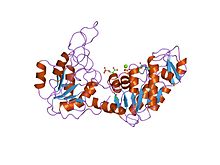Phosphoglycerate kinase
| Phosphoglycerate kinase | |||||||||
|---|---|---|---|---|---|---|---|---|---|
 |
|||||||||
| Identifiers | |||||||||
| EC number | 2.7.2.3 | ||||||||
| CAS number | 9001-83-6 | ||||||||
| Databases | |||||||||
| IntEnz | IntEnz view | ||||||||
| BRENDA | BRENDA entry | ||||||||
| ExPASy | NiceZyme view | ||||||||
| KEGG | KEGG entry | ||||||||
| MetaCyc | metabolic pathway | ||||||||
| PRIAM | profile | ||||||||
| PDB structures | RCSB PDB PDBe PDBsum | ||||||||
| Gene Ontology | AmiGO / EGO | ||||||||
|
|||||||||
| Search | |
|---|---|
| PMC | articles |
| PubMed | articles |
| NCBI | proteins |
| Phosphoglycerate kinase | |||||||||
|---|---|---|---|---|---|---|---|---|---|

Structure of yeast phosphoglycerate kinase.
|
|||||||||
| Identifiers | |||||||||
| Symbol | PGK | ||||||||
| Pfam | PF00162 | ||||||||
| InterPro | IPR001576 | ||||||||
| PROSITE | PDOC00102 | ||||||||
| SCOP | 3pgk | ||||||||
| SUPERFAMILY | 3pgk | ||||||||
|
|||||||||
| Available protein structures: | |
|---|---|
| Pfam | structures |
| PDB | RCSB PDB; PDBe; PDBj |
| PDBsum | structure summary |
| phosphoglycerate kinase 1 | |
|---|---|
| Identifiers | |
| Symbol | PGK1 |
| Entrez | 5230 |
| HUGO | 8896 |
| OMIM | 311800 |
| RefSeq | NM_000291 |
| UniProt | P00558 |
| Other data | |
| EC number | 2.7.2.3 |
| Locus | Chr. X q13.3 |
| phosphoglycerate kinase 2 | |
|---|---|
| Identifiers | |
| Symbol | PGK2 |
| Entrez | 5232 |
| HUGO | 8898 |
| OMIM | 172270 |
| RefSeq | NM_138733 |
| UniProt | P07205 |
| Other data | |
| EC number | 2.7.2.3 |
| Locus | Chr. 6 p21-q12 |
Phosphoglycerate kinase (EC 2.7.2.3) (PGK 1) is an enzyme that catalyzes the reversible transfer of a phosphate group from 1,3-bisphosphoglycerate (1,3-BPG) to ADP producing 3-phosphoglycerate (3-PG) and ATP. Like all kinases it is a transferase. PGK is a major enzyme used in glycolysis, in the first ATP-generating step of the glycolytic pathway. In gluconeogenesis, the reaction catalyzed by PGK proceeds in the opposite direction, generating ADP and 1,3-BPG.
In humans, two isozymes of PGK have been so far identified, PGK1 and PGK2. The isozymes have 87-88% identical amino acid sequence identity and though they are structurally and functionally similar, they have different localizations: PGK2, encoded by an autosomal gene, is unique to meiotic and postmeiotic spermatogenic cells, while PGK1, encoded on the X-chromosome, is ubiquitously expressed in all cells.
PGK is present in all living organisms as one of the two ATP-generating enzymes in glycolysis. In the gluconeogenic pathway, PGK catalyzes the reverse reaction. Under biochemical standard conditions, the glycolytic direction is favored.
In the Calvin cycle in photosynthetic organisms, PGK catalyzes the phosphorylation of 3-PG, producing 1,3-BPG and ADP, as part of the reactions that regenerate ribulose-1,5-bisphosphate.
...
Wikipedia
